A while ago I decided to customise a camera and lens, or more precisely a Leica M3 DS and a Canon 50mm f/0.95…
I won’t go into a review of the camera and lens themselves; I’ve already done that for the lens, at least (review here) and Hamish has written extensively about the Leica M3. This article is in response to Hamish asking me the very simple question: “why?” (and to me adding to that ‘how’).
Back-to-basics
One of the main reasons I moved (and now mainly shoot) film was that I wanted to get back to basics; to learn what the various functions of a camera do and how each variable affects the image. To do this I felt that I needed to get as far away from a digital camera with hundreds of features as possible. I just wanted ISO, shutter speed and aperture to play with.
After extensive research online I set my sights on a 1950’s rangefinder and with that decision made I made my way over to Ebay and found a beaten up Leica M3 rangefinder which came with a Leica 50mm lens. This was just what I’d been after – a shutter speed dial on the body and the aperture ring on the lens being the only variables (once ISO had been set for the next 36 shots).
From this one camera and lens combination I’ve chopped and changed over the past few years dipping into medium format with Hasselblads, trying out the early SLRs with a Nikon F2AS and with various (read ‘many’) others in between.
It’s been pretty obvious the whole time that I’ve been experimenting with all of these different cameras (and lenses) that the Leica was what I was gravitating back to time and again. The solidity of the brass body, the smooth winder mechanism, the simplicity of use. I’ve tried M2s, an MP, an MDa with ultra wide lenses, an M7 and even a digital M8, but it’s the M3 that I reach for every time.
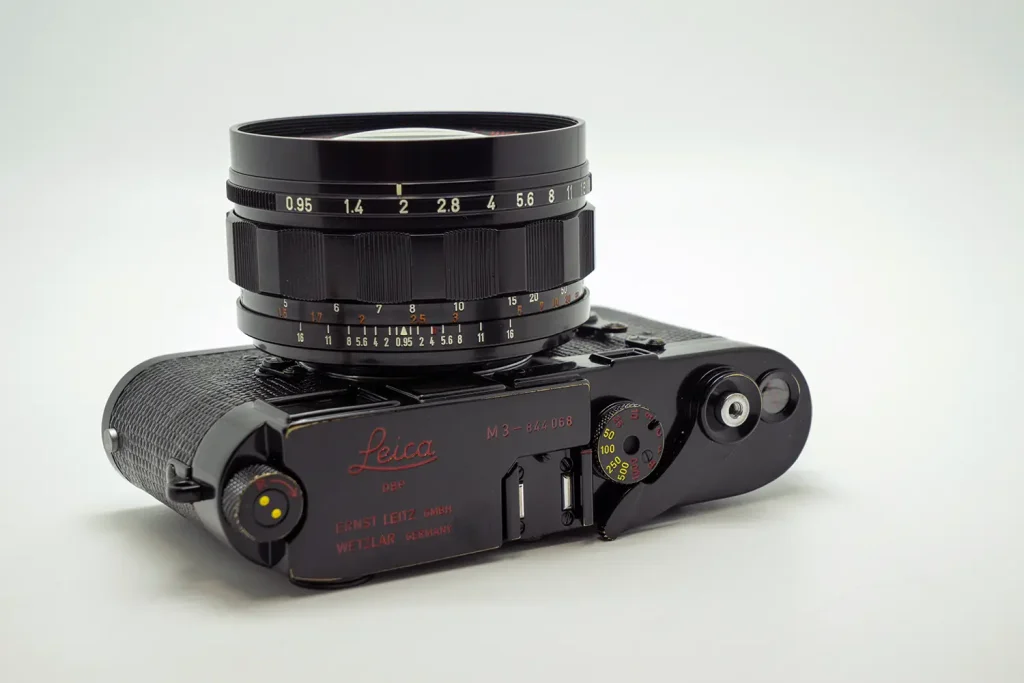 Photo courtesy of Japan Camera Hunter.
Photo courtesy of Japan Camera Hunter.
Japan Camera Hunter
As anybody researching film cameras will know, you won’t have to spend much time on the internet before eventually stumbling upon the Japan Camera Hunter JCH website run by Bellamy Hunt in Tokyo.
I became an avid reader of his lens and camera reviews. One article in particular piqued my interest – on the repainting of his Leica M3 by a company in Tokyo called Kanto.
The thought of having an old M3 Leica rebuilt and repainted to be ‘as new’ appealed to me. None of the current film Leicas (MP or MA) struck me as that interesting – the two main reasons being the magnification of the viewfinders and also my preference for the ‘double stroke’.
The JCH article also said that lenses could be repainted too. This gave me an idea…
The rebuild
I’d been thinking about what style of shooting I wanted to do and what set-up would work best for me. I was set on the 50mm focal length as the aesthetic was exactly what I wanted and it was the optimal length for the M3 viewfinder.
I wanted something fast that could be shot in low light. I’m not overly fussed about cutting edge digital-age sharpness and character-flaws like vignetting and the lens’ well documented ‘softness’ appealed to me.
I had read a bit about the Canon 0.95 and owned a Canon 50mm 1.2 LTM which I used with an M-mount adaptor on the M3. The 1.2 was a great lens for me (I know some people hate it, though) and I particularly liked the focus ring and bulk of it in comparison to some of the similar Leica offerings.
There were other fast fifty options out there but the Noctilux was way out of my price range and actually might have been too Leica-sharp for my tastes and I just didn’t like the look of the Voigtlanders. I’d see versions of the Canon 0.95 converted to M-mount. I emailed Bellamy and he said he could convert it if I sent him one or he could find one to convert.
So I set about searching for a good copy on eBay and in the end bought a Canon 7s with 50mm attached from a reputable dealer in Germany – I subsequently sold the body separately. When it arrived it looked in good condition, if a little dirty. I forwarded it to Bellamy.
The donor Leica M3 I’d also purchased on Ebay. It was in pretty bad shape and I was worried that it might not be fit for purpose but Bellamy assured me that the guys at Kanto would bring out the best in it. He wasn’t wrong.
The Leica M3
I wanted an early version M3 as I prefer the double stroke winder action. I know lots of people prefer the single stroke but I have a habit of taking a shot and automatically forwarding the film advance one stroke.
When I have a single stroke camera this means I have the potential to accidentally take a shot or end up taking a dud if I can’t find anything to shoot before putting it back in my bag. With the double stroke I’m fine; once I see the shot I want I advance one stroke again and I’m set. So for me, the DS is the one to have.
I wanted the camera to be discreet, especially for shooting on the street. I’d seen Leica’s painted other colours than black and Bellamy had told me of one guy who’d even painted his the same colour as his Ferrari. I scoured the web looking at what had gone before and made my mind up that black might be a bit boring but it fit the bill of being both discrete and classic.
Initially, I sent JCH specific pantone colours for the reds and yellows to be used for the lettering. I wanted to use a particular Match Technical soft release called Opera Act II. I emailed Tim Isaac at Match Technical and asked him if he would mind me knowing the pantone colours that he used. Tim was very kind and a few days later he emailed me the details.
The pantone for the red was Pantone 200C and the yellow was 116C. However, Kanto weren’t too sure about matching exactly and they said that the cost would be prohibitively high for them to get it right. I decided the extra expense wasn’t worth the hassle and in hindsight I much prefer this more muted, darker red.
Body
There are a number of options that Kanto give you to paint the camera – matte, semi-matte, semi-gloss etc. I went for high gloss as I wanted the effect of a new camera.
In complete contradiction to this last statement I then asked Bellamy if I could have a bit of brassing too – in his original article his black repaint had been brassed to show the skill of Kanto in being able to replicate ageing on an newly painted camera. I went for less brassing than his – you can only really see it on the corners.
One of the main reasons for doing this was that if I had had it ‘as new’ I would have been paranoid about scratching it for the first time and since this was meant to be my new full time shooter I figured get the scratching out the way early! It’s worked and right from the off I’ve just thrown the camera in my bag without a second thought to the odd ding or scratch.
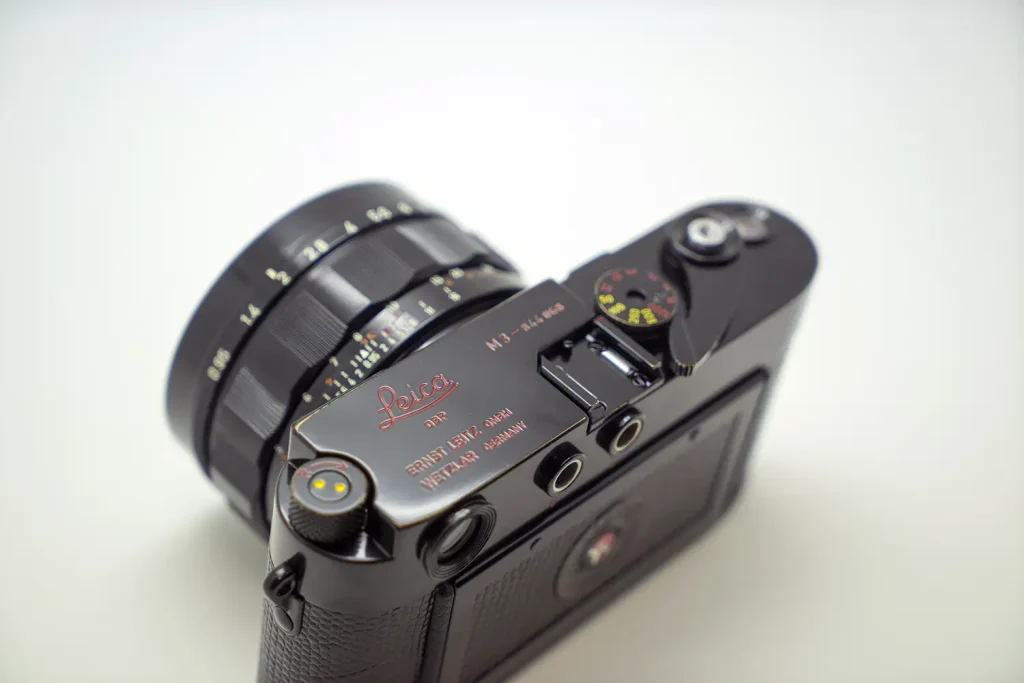
Photo courtesy of Japan Camera Hunter.
Top plate script
I had all of the top plate in red lettering – I kept all of the original script. I did talk to Bellamy about maybe getting some custom script but decided against it. I’ve seen in a video on the making of the Leica a-la-carte that you can have your signature engraved. However, in the end I decided against it as it would have cluttered the camera.
Shutter dial
I opted for red for the slow speeds B to 25 and yellow for 50 to 500. I accidentally omitted 1000 which is in red. This was a mistake. As I said before yellow is more easily seen and I figured I don’t really use the slower speeds as I don’t have the steadiest of hands and find my shots below 1/50 tend to start to blur. If I need to look down quickly I just wanted to be able to see the speeds I use most often.
Film advance lever
I opted for this in black paint. I thought that chrome, red or yellow would be too distracting. The thread for the cable release had to stay in chrome but I knew this would be covered by the soft release anyway.
Frame counter
I opted for black background as per Bellamy’s repaint in his article, with red lettering. In hindsight I would have done the numbers in red from 2 to 35 and yellow for 1 and 36 – my reasoning is that the red is hard to read and I never really know when I am near the start or end of a roll. 1 and 36 are the only ones I’m all that interested in.
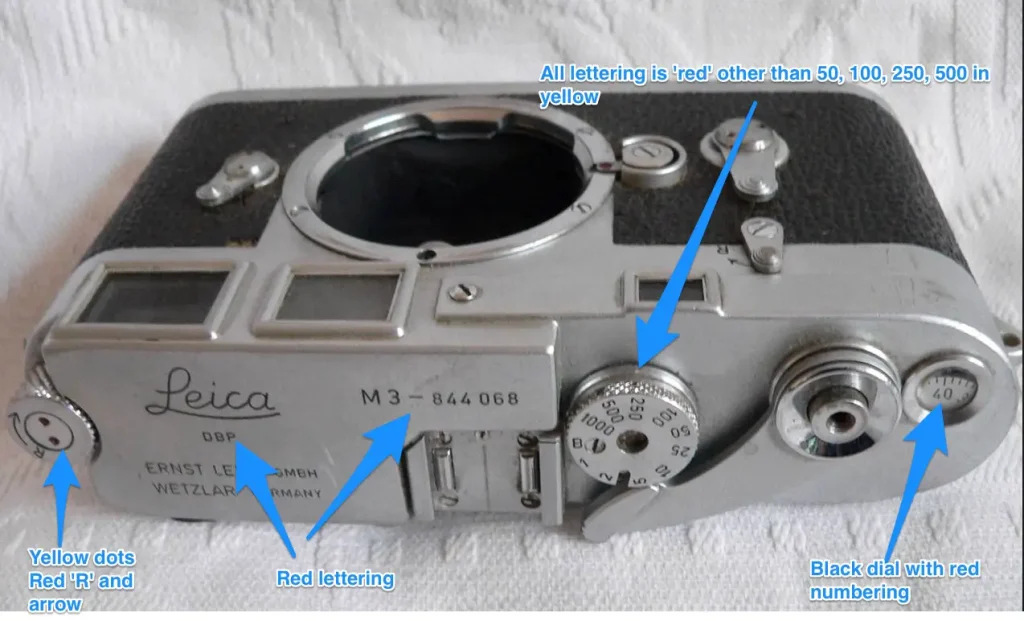

Photo courtesy of Japan Camera Hunter.
Base plate
This is in black paint with red lettering for the open and close. The catch to open the base is still in chrome. I wasn’t able to have this in black, otherwise I would have.
ISO reminder
This has DIN and ASA settings on it. I opted to black out the DIN as I don’t use them, leaving the ASA in red. The indicator for black & white, tungsten or daylight was left the same as I figured it worked and would be too much hassle to change.
As Hamish has mentioned in some of his Leica M reviews, the metal M3 reminder is pretty unique – the MP is a horrible plastic – only the new MA has metal. It speaks to the build quality of the M3 that even this sort of detailing is of such high quality.
Flash sync sockets
I didn’t want these showing as chrome and so I sourced two matte black silicon plugs from Peter at CRR Luton. I actually only need one as the thumbs up covers the other and with the plug in it won’t sit flush to the back of the camera anyway.
The icons above the sockets are coloured in red.
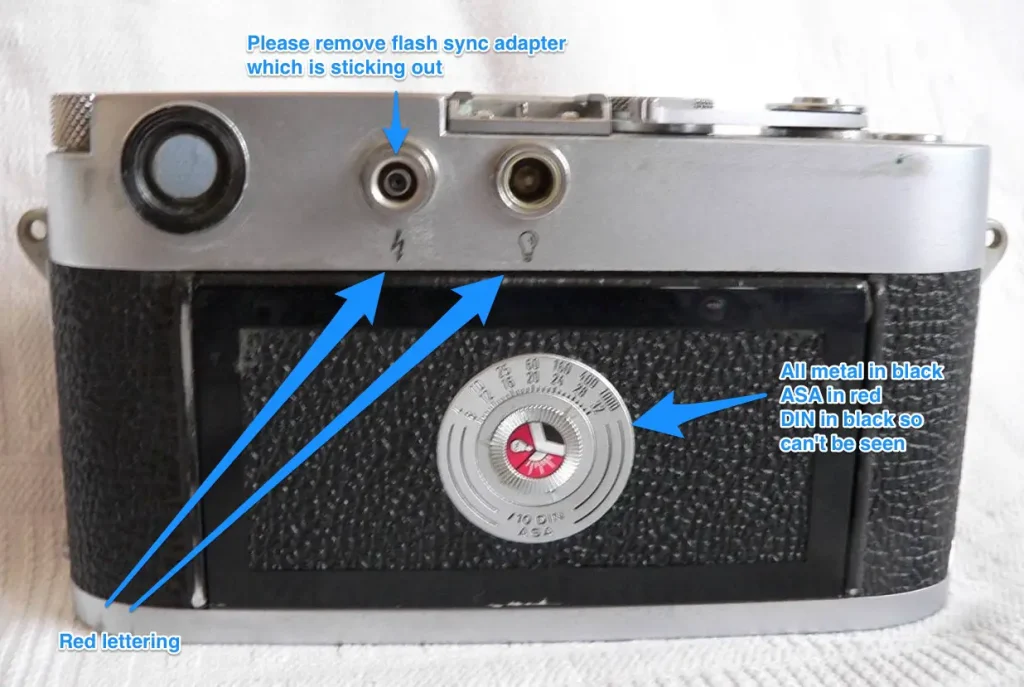
Photo courtesy of Japan Camera Hunter.
Rewind knob
I considered a rapid wind lever but the ergonomics are not quite for me. Although, I do find it faster to rewind the film I find it keeps snagging on things when I am putting the camera away. It’s also not that comfortable to use and aesthetically I don’t like it.
I stuck with black paint for the knob rather than chrome and decided to have the R and -> in red, the two dots that display when the film is advancing in yellow.
The reasoning behind this is that the red paint is discreet (in some light you really have to look to be able to see the lettering). The yellow is clearer. I only need to see that the film is advancing; I know which direction to wind the film without looking.
Camera front body
The lettering is in red for the rewind lever to keep it discrete.
On the lens mount (where nobody will ever see) I had the dot to indicate coupling painted yellow as this is something I want to be able to see in low light when changing lenses.
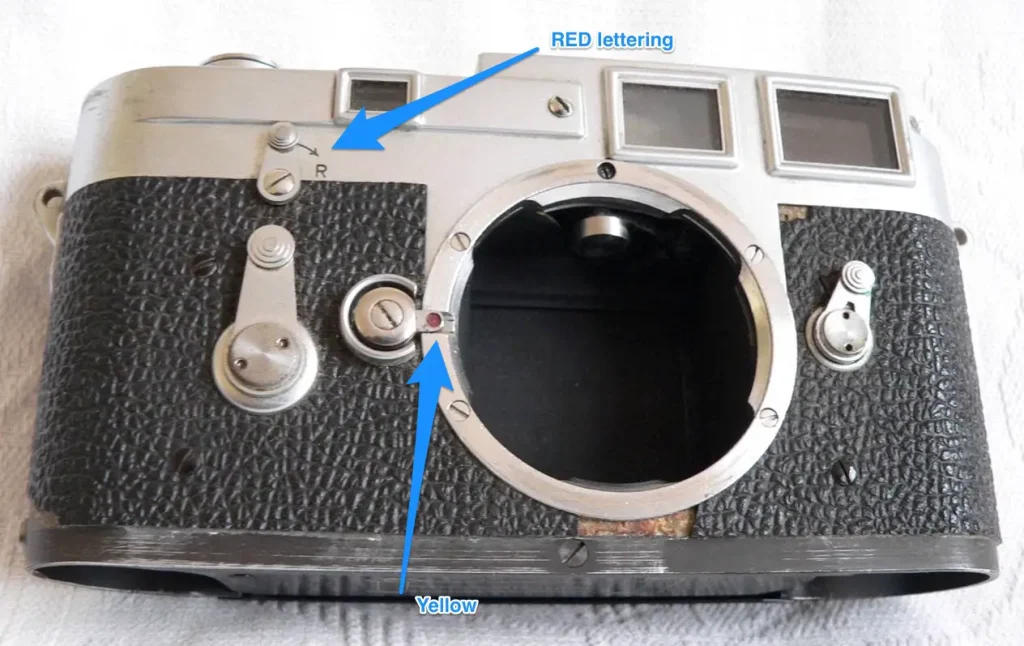
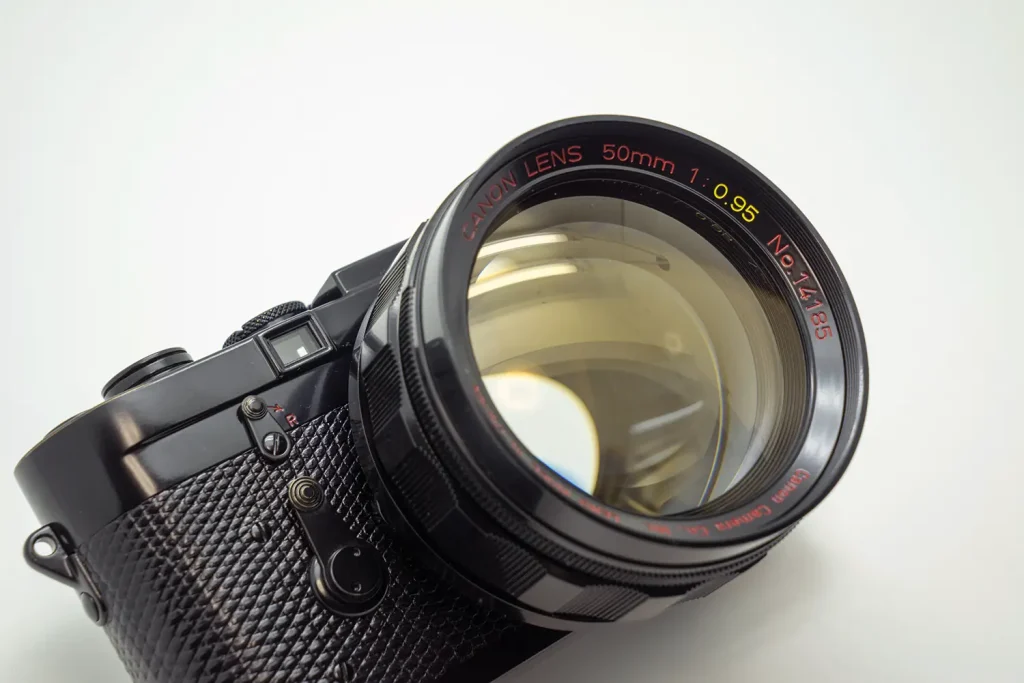
Lens Cap
I’m a stickler for things matching (as you might have guessed) and so I asked for the lens cap which was chrome to be painted in the same high gloss black. I did consider having the Canon spelt out in red but in the interest of keeping it discrete (and to prevent Bellamy’s head not exploding) I decided against this.
Leatherette
I originally thought about a crocodile or alternate skin but in the end went for the black lizard. It has a real high gloss look to it and isn’t too distracting. It also has a very ‘grippy’ texture which is useful when holding the camera. Bellamy had a number of options that he showed me in various colours and patterns.
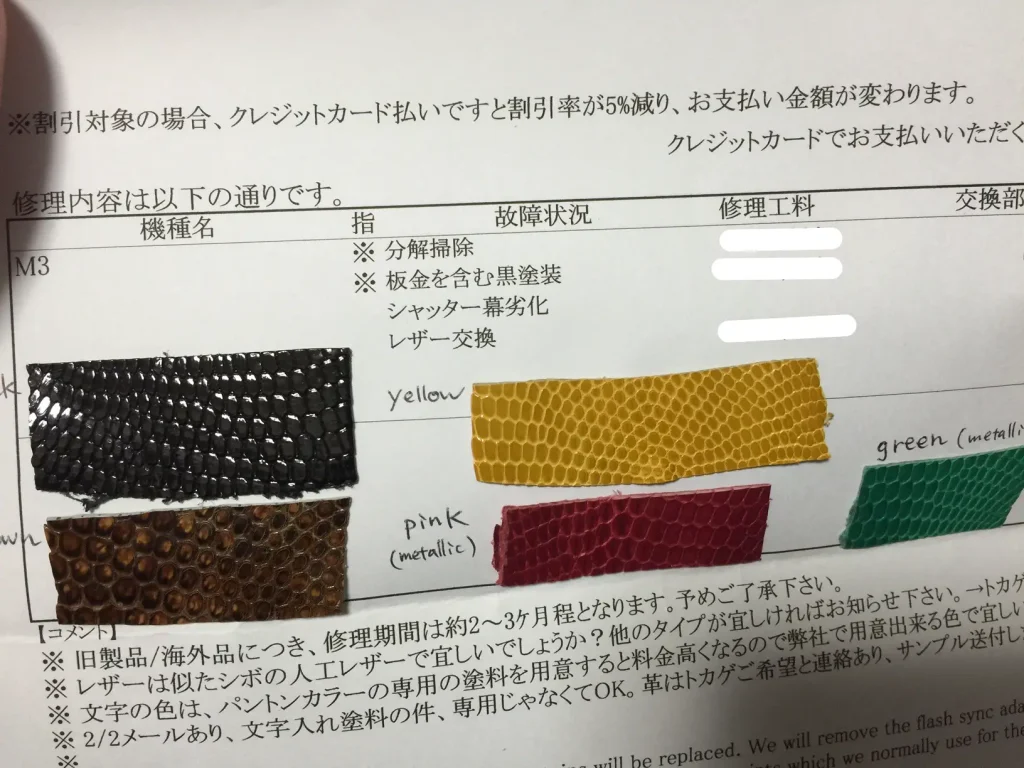
Photo courtesy of Japan Camera Hunter.
Match Technical Thumbs Up EP1S
In my research I had seen a few articles that had said it was possible to squeeze another 1/2 to 1 stop of exposure out of shots by using two items that could be attached to the camera to hold it steady. The first of these was the Thumbs Up.
I have had this over a year now and it feels odd holding a Leica now without one. It really does make holding an M-body one handed so much easier and I do think that when shooting two handed (and really wanting to be steady) that it helps (if only slightly). I did consider having this repainted too but actually the one I have is black and has started to brass nicely and fits the look of the camera really well.
Match Technical Soft Release – Opera Act II
The other item was a soft release. It may sound slightly odd but the colour scheme for the camera actually started here. I really liked the Opera Act II that I purchased from Match Technical. The black, yellow and red really seemed to work well together and in the interest of everything matching I decided that these would be the 3 colours.
I’ve studied interior design for my day job and as a result was aware of the concept of ‘complimentary colours’ and realised that red and yellow should work well together.
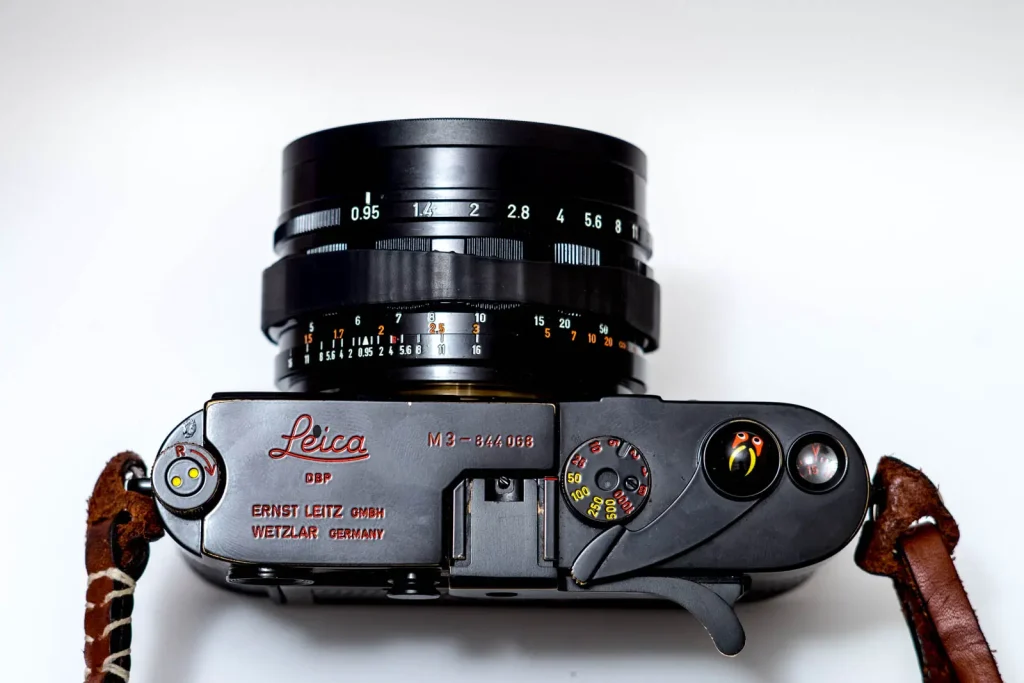
Cub & Co Shooter Strap
I’ve researched a lot of straps on the internet and purchased a few to try. I won’t go into a full blown review of each here but will concentrate on the one that I went for for this set up.
I like the adjustable nature of the Shooter Strap from Cub & Co. I started with their Russet colour but emailed the always very helpful owner, Joel Chavez, and he kindly agreed to make a custom strap using red and yellow yarn for the stitching.
Since receiving the camera I actually found that I prefer the russet and so this is what I have ended up keeping on it. The strap decision was very important to me as it is integral to the way I shoot and, of course, how comfortable it is to carry the camera.
The bumpers around the lugs are useful to make sure that the paint doesn’t get too scratched by the rings. The adjustable nature of the strap means that I wear it long around my body when I’m carrying it and then I shorten it and wrap it around my hand when I am shooting.
The Canon 50mm f0.95
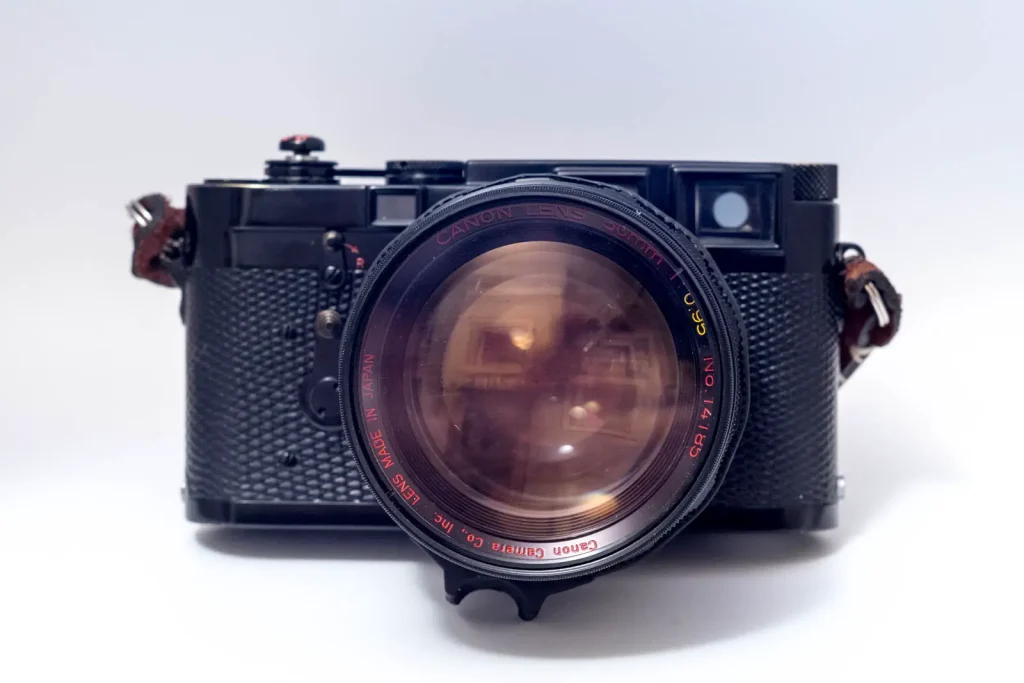
I wanted the lens to look as if it were made for the camera. I wanted the paint exactly the same. For the aperture and distance markings I did consider keeping with the red and yellow theme and doing something really bespoke but in the end three things stopped me (a) I couldn’t be bothered coming up with a suitable system that would make sense in terms of depth of field, focus distance etc, (b) I wasn’t sure if the red was going to be readable at all and I use distance markings to focus in low light and wanted half a chance of being able to use them and (c) I thought Bellamy might kill me. By this point I had sent him a LOT of emails about the different parts of the camera and different ideas I was having. He is a very nice guy but I didn’t want to push my luck by hassling him too much. Maybe on a future project…
The front element, however, I wanted to be different. It’s a big lens and when you point it at people they are going to look your way. As a result I went with the red so that really it just looks like a black disc but wanted a bit of contrast so decided to have the 0.95 stand out in yellow.
As mentioned above, when I purchased the lens it wasn’t in perfect condition and definitely had dust and haze inside .Kano dismantled and cleaned the lens and when it came back, with the exception of some minor historic cleaning marks on the front element, it looked as new.
M-mount
As this was going to live on the M3 it needed to be in M-mount. Bellamy said that although Kanto could do this for me, the best person would be Mr Miyazaki of MS Optical in Chiba, Japan. He took the repainted, cleaned and rebuilt lens from Kanto and installed a 6-bit coded M-mount replacement for the Canon 7 mount.
Taab focussing ring
Although, I prefer the look of the lens without this I have since added one for the simple reason that it makes shooting so much easier. The long 180 degrees throw of these old Canon LTM lenses can be difficult when focussing from near to far quickly (and vice versa). The lens tab just makes things that little bit easier and with a bit of practice I can move and adjust the focus even before the camera reaches my eye for the shot.
Skylight filter
I’ve attached a black BDB 72mm 1A filter to protect the front of the lens. As I’ve said previously this really is my go-to set up and as a result it doesn’t always get thrown in a padded bag – sometimes it’s thrown under a pram or in a car glove compartment etc and my 18 month old son occasionally gets to it before me.
I’d be angry with myself if I scratched it on the front element after having gone to so much trouble getting to this point and so have succumbed to the filter. I know some purists will not be happy that I’ve put something in front of some expensive glass, but it’s peace of mind for me and let’s face it, it’s 1950’s glass and the filter doesn’t make a noticeable difference (at least not to my eye).
Instead of getting a modern filter, though, I’ve stuck with a vintage version and it’s in black (obviously). At some point I may send it off to be repainted – the white font is distracting and the black is not the same black as the lens. Small details, but then that is what this project is about.
Timeframe
I posted the camera and lens from the UK to Japan in early January 2015. They arrived back in May 2015. A little under the quoted six months.
Costs
I’ve purposefully haven’t mentioned costs for any of this. For two reasons, really:
(1) I’m slightly embarrassed that I’ve spent so much basically ‘painting my camera black’ and (2) Bellamy has a business to run. If I put a price on here it’ll act as as a benchmark for however long this stays on the internet, which isn’t fair to him given the ever changing photography market. The last thing I want is for him to have people contacting him quoting old prices.
If you’d like to know the costs, please get in touch with him – I really can’t recommend his service, professionalism and knowledge enough.
What I will say, though, is that the build up of costs were as follows: Bellamy’s, not inconsiderable, time; the labour for the repaint of the lens and body; the spare parts for the body; the cleaning of the lens; the remounting of the lens by MS Optical; shipping to and from Japan and the donor camera and lens. The 3rd party items like the Match Technical pieces I purchased myself direct from the suppliers.
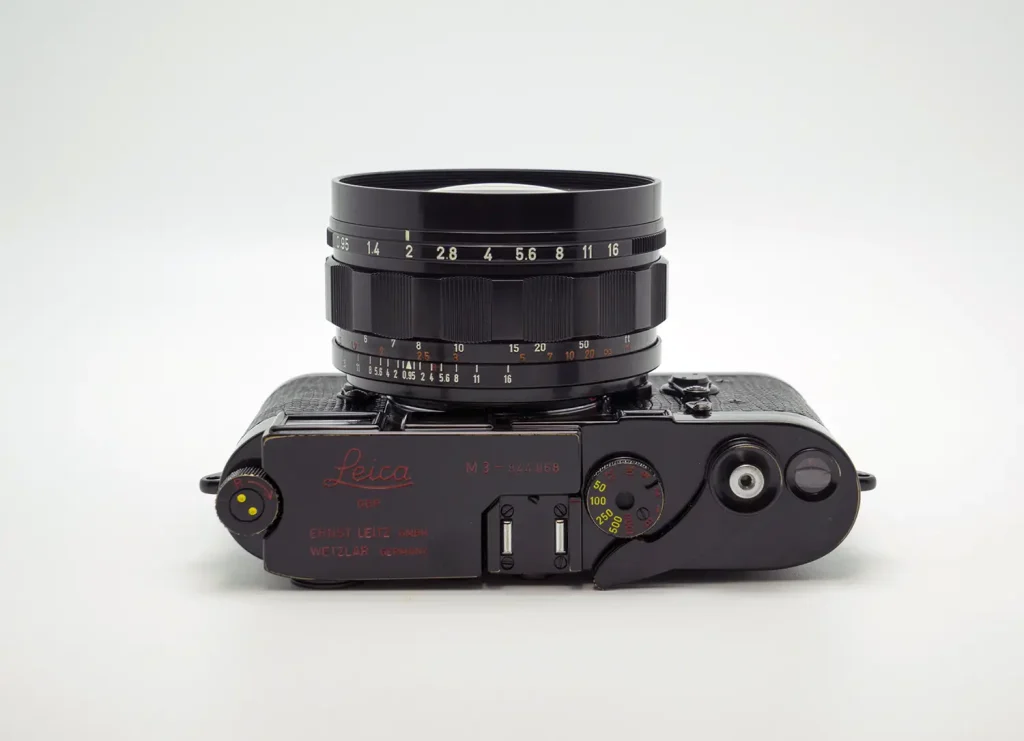
photo courtesy of Japan Camera Hunter.
Summary
I really enjoyed putting this camera setup together. I am sure there are some people out there who will think it a waste of time and money (and maybe they’re right). I’ve also had two people complain that I’ve butchered a Canon lens which was never meant for a Leica body. My only defence is that at least it’s getting used on a regular basis.
Every single time I pick this camera and lens up I love using it. I have a few cameras to choose from but this is the one I reach for all the time. It’s even led to be me selling a load of lenses as I just don’t use them anymore.
I still haven’t reduced my collection down to the ‘one camera, one lens’ which I’ve tried to do but I am getting there and the M3 body is still the only Leica that I now own. Coupling it with a Canon 85mm f1.8 LTM and my 16mm f8 Hologon (the very lens that Hamish recently reviewed) means that my bag has everything I could possibly want for a day/holiday etc.
Anyway, I hope this has been an insight into the ‘why’ someone might want to repaint their camera and also a sort of ‘how to’ for those who are considering it for themselves. Now that Voigtlander has killed off the Bessa there are very few manual rangefinders that you can buy new (Leica’s M-A being one of the few, if not the only one) and so a rebuild like this might be the only option in a few years time.
Given that there are only a finite number of these cameras out there it’s inevitable that the ones being used (rather than in display cabinets) will deteriorate over time.
I really feel that the work that Bellamy and companies like Kanto are doing will mean that the lifespan of these cameras will go way beyond what the original manufacturers ever dreamed of.
I wait to see whether the same will be true of digital. Maybe I’ll be surprised and in 50 years time there’ll be some guy who’s the guru of mending circuit boards and maintaining software for 2015 cameras.
What I do hope, though, is that there’ll be a heap of custom repaints out there prolonging the lives of these amazing cameras and lenses and giving future generations the please of knowing the joy of simple, no gimmicks, photography.
Share this post:
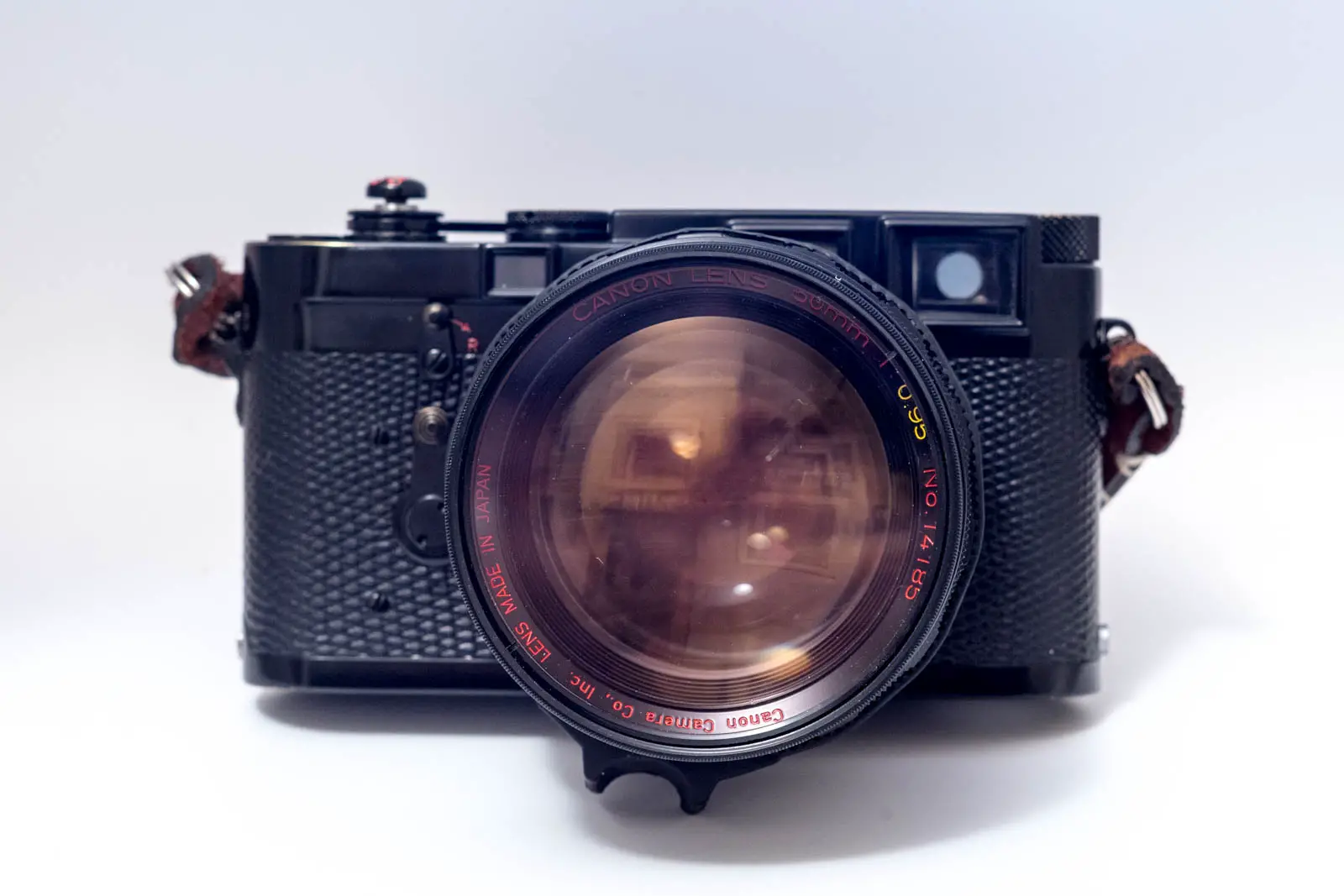
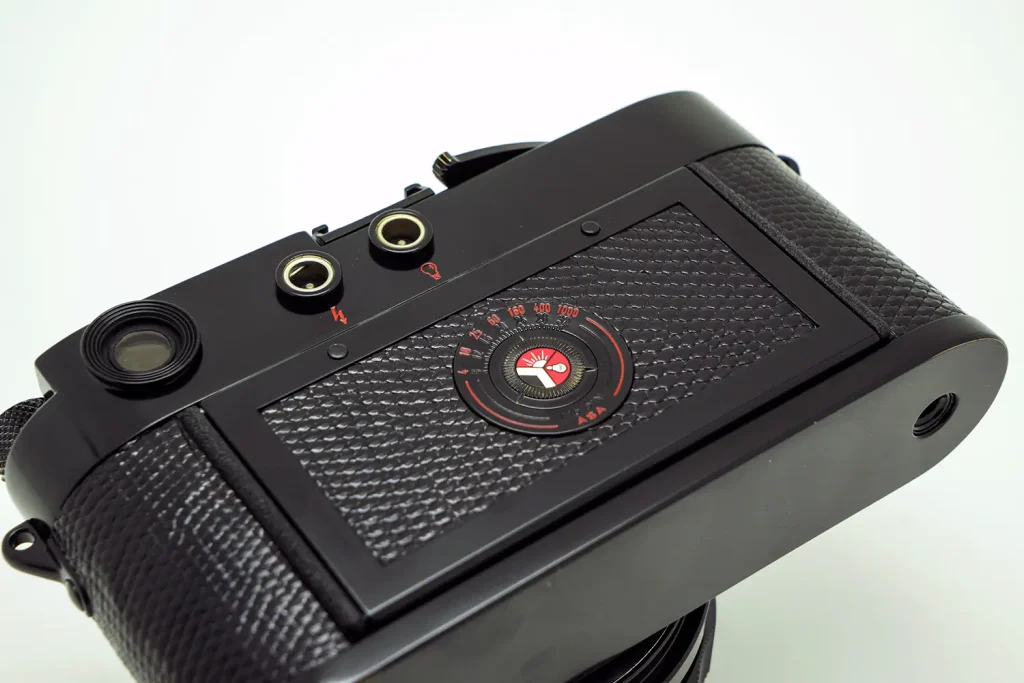








Comments
Hamish Gill on Creating the (my) perfect camera – Guest Post By James Fox-Davies
Comment posted: 03/11/2015
A difficult question I've been holding off asking you ... Is there anything you would choose differently if you were to do it over again?
Comment posted: 03/11/2015
Comment posted: 03/11/2015
Comment posted: 03/11/2015
Blinx on Creating the (my) perfect camera – Guest Post By James Fox-Davies
Comment posted: 03/11/2015
Fascinating project nonetheless. A ball park figure for the whole enterprise would have been useful. North or south of £4k is the question...?
Comment posted: 03/11/2015
Tony on Creating the (my) perfect camera – Guest Post By James Fox-Davies
Comment posted: 04/11/2015
Comment posted: 04/11/2015
Ray on Creating the (my) perfect camera – Guest Post By James Fox-Davies
Comment posted: 04/11/2015
Comment posted: 04/11/2015
Ken Hindle-May on Creating the (my) perfect camera – Guest Post By James Fox-Davies
Comment posted: 04/11/2015
Comment posted: 04/11/2015
The (my) perfect camera - Barnes Photographic SocietyBarnes Photographic Society on Creating the (my) perfect camera – Guest Post By James Fox-Davies
Comment posted: 04/11/2015
Francois on Creating the (my) perfect camera – Guest Post By James Fox-Davies
Comment posted: 05/11/2015
Very cool combo.
Comment posted: 05/11/2015
Ray on Creating the (my) perfect camera – Guest Post By James Fox-Davies
Comment posted: 05/11/2015
Comment posted: 05/11/2015
Captain Grimes on Creating the (my) perfect camera – Guest Post By James Fox-Davies
Comment posted: 05/11/2015
jeremy north on Creating the (my) perfect camera – Guest Post By James Fox-Davies
Comment posted: 05/11/2015
JCH offers some superb customisation options,I enquired a while ago about a converting one of my Contax G lens to M mount but it was more expensive than buying an M lens so I didn't bother. He's got some nice vids on YouTube. it's nice that you speak so highly of him. It's just a pity he's not in Europe. I don't like buying stuff from outside of Europe because of the hammer blow of the HMRC import taxes and fees. On that, how does the import tax thing work when you are paying for a service as opposed to buying a camera?
Why did you opt for the 6 bit coding? Are you thinking of getting a modern Leica? I suppose it didn't cost a lot more than the basic conversion so that would make sense.
I am staggered by the price of a Match Technical Thumbs Up. How well though does the soft release work? It does look nice.
Thanks again for a fascinating read.
Comment posted: 05/11/2015
Comment posted: 05/11/2015
Comment posted: 05/11/2015
Tony on Creating the (my) perfect camera – Guest Post By James Fox-Davies
Comment posted: 05/11/2015
Comment posted: 05/11/2015
Tony on Creating the (my) perfect camera – Guest Post By James Fox-Davies
Comment posted: 05/11/2015
I must say that you've got me contemplating a custom job myself! Your project is quite inspiring.
Ric Capucho on Creating the (my) perfect camera – Guest Post By James Fox-Davies
Comment posted: 11/11/2015
Ric
Comment posted: 11/11/2015
The Canon 50mm f0.95 - Guest Review by James Fox-Davies - 35mmc on Creating the (my) perfect camera – Guest Post By James Fox-Davies
Comment posted: 12/11/2015
The Canon 85mm f1.8 LTM - by James Fox-Davies on Creating the (my) perfect camera – Guest Post By James Fox-Davies
Comment posted: 08/12/2015
Hayduke on Creating the (my) perfect camera – Guest Post By James Fox-Davies
Comment posted: 09/09/2016
Gavin Go on Creating the (my) perfect camera – Guest Post By James Fox-Davies
Comment posted: 25/04/2018